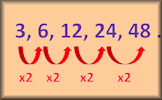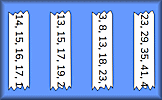Here are some specific activities, investigations or visual aids we have picked out. Click anywhere in the grey area to access the resource.
 Geometric Sequences An exercise on geometric sequences including finding the nth term and the sum of any number of terms.
Geometric Sequences An exercise on geometric sequences including finding the nth term and the sum of any number of terms. Geometric Sequences Video Revise all you need to know about geometric sequences and series.
Geometric Sequences Video Revise all you need to know about geometric sequences and series. Parts of Sequences Find the formula that describes the part of the sequence that can be seen
Parts of Sequences Find the formula that describes the part of the sequence that can be seen
Here are some exam-style questions on this statement:
- "The diagrams above show a growing fractal of triangles. The sides of the largest equilateral triangle in each diagram are of length 1 metre." ... more
- "A square is drawn with sides of length 32 cm. The midpoints of the sides of this square are joined to form a new square and four red triangles. The process is repeated to produce yellow triangles and then again to produce blue triangles." ... more
- "The first term of an infinite geometric sequence is 10. The sum of the infinite sequence is 500." ... more
- "In a geometric series the common ratio is \(r\) and sum to \(n\) terms is \(S_n\)." ... more
- "Consider a geometric sequence with first term 2 and common ratio 9." ... more
- "Chris checks his Twitter account and notices that he received a tweet at 8:00am. At 8:05am he forwards the tweet to four people. Five minutes later, those four people each forward the tweet to four new people. Assume this pattern continues and each time the tweet is sent to people who have not received it before." ... more
- "The sum of the first n terms of a geometric sequence is given by:" ... more
- "Consider the arithmetic sequence \( u_1, u_2, u_3, \ldots \)." ... more
Here are some Advanced Starters on this statement:
- Grandmother
How far would grandma have travelled after a suitably large number of days given her walking regime? more - Rice on a Chess Board
How many grains of rice are on a chess board if each square has twice the number of grains as the previous square. more - Same Series Sum
Find an arithmetic series and a geometric series that have the same sum of the first five terms. more
Click on a topic below for suggested lesson Starters, resources and activities from Transum.
Furthermore
A geometric sequence is a sequence of numbers where each term after the first is found by multiplying the previous term by a fixed, non-zero number called the common ratio, denoted by \( r \).
The \( n^{th} \) term of a geometric sequence can be calculated using the formula:
$$ u_n = u_1 \cdot r^{(n - 1)} \\ \text{where } u_n \text{ is the } n^{th} \text{ term, } u_1 \text{ is the first term, and } r \text{ is the common ratio.} $$The sum of the first \( n \) terms (\( S_n \)) of a geometric sequence can be found using the formula:
$$ S_n = \frac{u_1(1 - r^n)}{1 - r} \text{, for } r \neq 1 \\ \text{where } S_n \text{ is the sum of the first } n \text{ terms.} $$Sigma notation (\( \Sigma \)) is also used to represent the sum of geometric sequences. For a geometric sequence, it can be represented as:
$$ S_n = \sum_{k=0}^{n-1} u_1 \cdot r^k $$Example 1: Consider a geometric sequence where the first term \( u_1 = 2 \) and the common ratio \( r = 3 \). Let's find the \( 5^{th} \) term and the sum of the first 5 terms.
Using the formula for the \( n^{th} \) term:
$$ u_5 = 2 \cdot 3^{(5 - 1)} = 2 \cdot 81 = 162 $$So, the \( 5^{th} \) term is 162.
Now, using the formula for the sum of the first \( n \) terms:
$$ S_5 = \frac{2(1 - 3^5)}{1 - 3} = \frac{2(1 - 243)}{-2} = \frac{484}{2} = 242 $$Thus, the sum of the first 5 terms of the given geometric sequence is 242.
Example 2: For a geometric sequence with the first term \( u_1 = 4 \) and the common ratio \( r = 0.5 \), we can represent the sum of the first 4 terms using sigma notation as:
$$ S_4 = \sum_{k=0}^{3} 4 \cdot (0.5)^k $$This notation concisely represents the sum of the sequence: 4, 2, 1, and 0.5, which equals 7.5.
This video on Geometric Sequences is from Revision Village and is aimed at students taking the IB Maths Standard level course.
How do you teach this topic? Do you have any tips or suggestions for other teachers? It is always useful to receive feedback and helps make these free resources even more useful for Maths teachers anywhere in the world. Click here to enter your comments.

